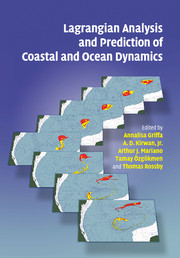Book contents
- Frontmatter
- Contents
- List of contributors
- Preface
- 1 Evolution of Lagrangian methods in oceanography
- 2 Measuring surface currents with Surface Velocity Program drifters: the instrument, its data, and some recent results
- 3 Favorite trajectories
- 4 Particle motion in a sea of eddies
- 5 Inertial particle dynamics on the rotating Earth
- 6 Predictability of Lagrangian motion in the upper ocean
- 7 Lagrangian data assimilation in ocean general circulation models
- 8 Dynamic consistency and Lagrangian data in oceanography: mapping, assimilation, and optimization schemes
- 9 Observing turbulence regimes and Lagrangian dispersal properties in the oceans
- 10 Lagrangian biophysical dynamics
- 11 Plankton: Lagrangian inhabitants of the sea
- 12 A Lagrangian stochastic model for the dynamics of a stage structured population. Application to a copepod population
- 13 Lagrangian analysis and prediction of coastal and ocean dynamics (LAPCOD)
- Index
- Plate section
- References
5 - Inertial particle dynamics on the rotating Earth
Published online by Cambridge University Press: 07 September 2009
- Frontmatter
- Contents
- List of contributors
- Preface
- 1 Evolution of Lagrangian methods in oceanography
- 2 Measuring surface currents with Surface Velocity Program drifters: the instrument, its data, and some recent results
- 3 Favorite trajectories
- 4 Particle motion in a sea of eddies
- 5 Inertial particle dynamics on the rotating Earth
- 6 Predictability of Lagrangian motion in the upper ocean
- 7 Lagrangian data assimilation in ocean general circulation models
- 8 Dynamic consistency and Lagrangian data in oceanography: mapping, assimilation, and optimization schemes
- 9 Observing turbulence regimes and Lagrangian dispersal properties in the oceans
- 10 Lagrangian biophysical dynamics
- 11 Plankton: Lagrangian inhabitants of the sea
- 12 A Lagrangian stochastic model for the dynamics of a stage structured population. Application to a copepod population
- 13 Lagrangian analysis and prediction of coastal and ocean dynamics (LAPCOD)
- Index
- Plate section
- References
Summary
Introduction
The study of Newton's second law of motion is a natural basis for all fluid dynamical problems and the Eulerian form of this law is the basis (in addition to the conservation of mass) of Euler (or Navier–Stokes) equations. Despite its primordial importance in Geophysical Fluid Dynamics (GFD, hereafter) the application of Newton's second law of motion to the rotating spherical earth is commonly done only briefly as an addendum to the fluid dynamical problems. A detailed analysis of these equations as applied to the motion of particles on the rotating spherical earth is the subject of the present paper, which summarizes the advances made in the subject in recent years. In particular a comparison between the dynamics on the β-plane and on the sphere will be carried out in order to highlight the ramifications of the inconsistent approximations made in transforming the spherical geometry to a planar one on the β-plane.
The complexity of the spherical geometry is the culprit behind the development of GFD in Cartesian coordinates. Several semi-analytical studies in spherical coordinates were published in the 1960s and 1970s (a review of these works can be found in Moura, 1976) but more recent studies on a sphere are mostly numerical. Recent discussions of the balance between acceleration, the Coriolis force and pressure gradient forces on the elliptical Earth, as well as the subtleties of the Coriolis force itself there, are given in Durran (1993) and Persson (1998).
- Type
- Chapter
- Information
- Lagrangian Analysis and Prediction of Coastal and Ocean Dynamics , pp. 119 - 135Publisher: Cambridge University PressPrint publication year: 2007
References
- 4
- Cited by

